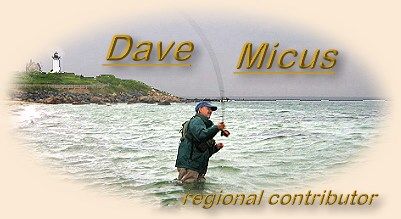|
"April is the cruelest month," suggested
T.S. Eliot, which tells me he was a New
Englander and a striped bass fisherman.
Come April, we in the northeast have been
waiting five long months to feel the throb
of a striped bass on the line, and, knowing
that May will bring the return of the fish,
April, already a long and dreary month,
seems longer and more dreary.
T.S. was talking in the aggregate, though,
as May can be pretty damn cruel too. As I
write this it is 42 degrees and we are into
the third day of a Nor'easter that, had it
occurred in January, would have dumped sixty
inches of snow. I still have the wood stove
going three weeks into May and the fishing
grapevine has had nothing to report, while a
check of my fishing log shows I caught bass
during the first weekend in May last year.
Imagine being a child and waking up on December
25 only to be told that Christmas will be delayed
for 21 days. That's how it feels.
But last Sunday a break in the weather gave
me a window of opportunity. I first cut the
grass so I could leave with a clear conscience,
then headed to an estuary system that fishes
well early in the season on a dropping tide.
I took the added precaution of calling Mike,
the guru on North Shore striped bass fishing
to seek his sage advice.
"I was there on Friday," Mike tells me,
lowering his voice (odd how fishermen do
that when talking of locations, even though
there is no one to hear), "and did well.
If you leave now you'll hit the tide right.
Work your way down to the first point.
That's where the fish will be. You won't
be alone there, but wait your turn. Fish
Clousers." That was all I needed. I didn't
have to pack the gear, as it has been packed
and ready to go since mid-April.

The area I'm fishing is owned by a land trust,
and the only access is a gated dirt road. It's
about a half mile walk from the road to the
water, which is a good thing because, like
rain, it discourages the weak-willed. The
walk is a pleasant one, and you can usually
see a wild turkey or pheasant, but, anticipation
being what it is, I always have to resist the
urge to run. Today the weather is overcast
and I'm pleasantly surprised to find that,
when I reach the water, I'm the only one here.
I enjoy fishing alone. It's not just that I'm
a curmudgeon, though I am, but I seek solitude
as much as fish.
In a previous trip to this same spot I encountered
a guide and his sport. The guide parked himself
right at the point and wouldn't budge, even though
it's a bit early in the tide and by starting up
stream and working my way down I'm getting more
and bigger fish than they are. As I near them
I hear that constant inane prater that some guides
feel compelled to spew, as if to assure their
sport that he is getting the total experience.
"Look at that!" this one shouts when a hooked
bass splashes on the surface. "He was tail
walking!" which is something I've never seen
a striper do, and I vow to myself that if I
ever again hire a guide, which is unlikely
unless it is Chris Chin in Canada, I'll insist
on meeting him for coffee prior to our trip to
assure that I don't shell out 4 c-notes to spend
seven hours with someone I want to strangle.

I wade about waist deep and choose a fly from
the fly wallet. Mike advised a clouser, but
I don't like fishing them. Don't misunderstand;
it is likely the greatest salt-water fly ever
conceived, and that is part of the reason I
don't like fishing them. Too many salt water
fly rodders fall into the deceiver/clouser rut,
and never expand their horizons. I compromise a
nd choose a clouser flat-wing of my own design,
a fly that I'm sure would cause a purist like
J. Kenney Abrams to conk me on the head. It
is tied like a traditional flat wing, only
upside down, with bar bell eyes on the top of
the hook shank, conceived in a fit of inspiration
during a winter session at the fly tying vise.
It casts as well as a traditional clouser, but
as I strip it near I notice that, oddly, it is
swimming with the hook point down, even with
the bar bell eyes on top of the shank. The
flat wing feathered tail, it seems, has neutralized
the weight of the bar bell eyes, and this fly
will end up in the drawer of original flies that
seemed brilliant when conceived, but...
I tie on a traditional clouser.
I begin catching fish right off, quite small,
but that doesn't matter. After not feeling
a saltwater fish on the line for six long months I had
begun to wonder if even catching fish on a
fly rod with feathers as bait is possible.
After all, what is a greater leap of faith
than believing you can imitate bait fish with
bird feathers? So these small fish are a thrill,
hunger being the best sauce.
On one cast I catch the smallest bass I have
ever seen, and I'm not sure if he was trying
to eat the clouser or the clouser was trying
to eat him. I am barely able to slip my thumb
in his mouth as I unhook him, and I notice
that his eyes are literally bugging out of
his head, as if he hadn't learned in school
the threat the fisherman poses as he migrates
from the Chesapeake to Maine and back. I
unhook him quickly and let him go, and maybe,
just maybe, he has learned a lesson that will
let him mature to a 38 inch bass someday.
When I work down to the point a rip is forming.
I clip off the clouser and tie on a Rays fly.
I think the Rays is the perfect fly; easy to
tie, productive, and so aerodynamic that it
adds about ten feet to my cast. If I were able
to fish only one fly for striped bass, it would
definitely be a Rays. The bass like it too. I
get the first substantial hit of the day when I
cast the Rays fly into the rip, and when the fish
shakes its head I can tell it's a fair sized bass.
He fights well and when I land him I'm surprised
to see he's 24 inches. Maybe it was the current,
or maybe just early season optimism, but he felt
bigger than that. I release him and on the very
next cast I catch his identical twin.

The tide, meanwhile, recedes to low, the bite
stops, and it's time to leave. I am never able
to just reel in and go, so I play "ten casts,"
a game where I throw ten more casts, and if I
don't catch a fish I reel in on the tenth cast
and call it a day. If I do catch a fish during
any of the ten casts I start over again with ten
more casts. Poor casts are Mulligans and do not
count. Today I throw nine casts without a bite
and reel in on the tenth (which often produces
a strike as the bass are sometime attracted to
the constant motion of the fly being reeled
in-but not today). I glance at my watch for
the first time and am amazed to see that I have
been fishing for 3 hours. If you had asked me
how long I'd been here, I would have said about
an hour. Funny how fishing is like that. I end
the day with 13 fish, 11 of them quite small but
two large enough to take line off of the reel and
I'm content with this outing.
On the walk back down the road I encounter
a mother and her young son. He is carrying
a spinning rod, and when she sees that I'm
leaving she says, "Oh, no, we're not too late,
are we?" I'm afraid they are. It's slack tide
right now, and, like most places, this spot
fishes best when the water is moving. The boy
looks at me pleadingly.
"No," I say, "I just decided to call it a day.
You should do just fine."
And I hope they do. ~ Dave
About Dave:
 Dave Micus lives in Ipswich, Massachusetts. He is an
avid striped bass fly fisherman, writer and instructor.
He writes a fly fishing column for the Port City Planet
newspaper of Newburyport, MA (home of Plum Island and Joppa Flats)
and teaches a fly fishing course at Boston University.
Dave Micus lives in Ipswich, Massachusetts. He is an
avid striped bass fly fisherman, writer and instructor.
He writes a fly fishing column for the Port City Planet
newspaper of Newburyport, MA (home of Plum Island and Joppa Flats)
and teaches a fly fishing course at Boston University.
|









